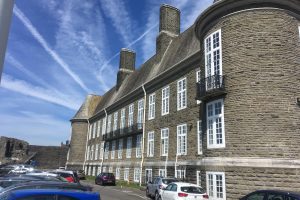STORM DARRAGH, which swept through South Wales last December, left a lasting mark on many communities — including Craig y Nos Country Park, where around 200 mature trees were lost in a single day and many more now being removed due to their unstable condition.
Craig y Nos Country Park is a 40-acre site that forms part of the grounds of the Victorian Craig y Nos Castle which lies just north of Abercrave in the village of Glyntawe. The park is managed by the Bannau Brycheiniog National Park Authority and comprises mixed woodland, a Sight of Special Scientific Interest (SSSI), a hay meadow and several ponds. The River Tawe, the source of which lies a couple of miles north of the site, runs through its grounds. The Castle is renowned as the former home of the famous opera singer Adelina Patti who created the gardens and planted many ornamental specimens which are still there today. Even though the Castle is now run as a private enterprise, the strong historic connection between Patti and the country park remains.
The University’s School of Architecture, Construction and Environments has a long history of working at the country park, providing volunteers and work parties for scrub removal and hedge planting, and recent work has seen a group of students and staff from across the University team up to assess the damage cause by last December’s storm.
Professor Rhian Jenkins, UWTSD’s academic director for the School of Architecture, Construction and the Environment said: “Having lived in the vicinity for a long time, it has been clear that weather patterns are changing and precipitation and flooding events are increasing at an alarming rate.
“The site is prone to flooding and the almost continuous rainfall over the last few years is having a detrimental impact on local soils. As a result, many of the trees in the area are not adapting to the changing conditions. While the storm was an extraordinary event, many trees were already displaying signs of stress and decline”.

“Climate change is visibly altering our natural habitats and there is now an interesting debate around ‘what is native’. We posed the question, should the Country Park replant destroyed environments with a ‘like for like’ planting scheme which would continue to honour the Adelina Patti legacy, or, is this the time to consider more appropriate planting which will continue to thrive as our climate changes”?
At the end of March, a group of staff and students from a range of the University’s disciplines, visited the site to conduct surveys and consider how to capture and communicate the need for change effectively.
The students’ objective was to gain an understanding of the current landscape status and capture environmental data to help support the decision-making process on how to adapt the existing habitat management plan.
Environment, Sustainability and Climate Change students conducted habitat surveys, and soil sample measurements which were later analysed in the University’s environmental laboratory at the University’s Waterfront campus in Swansea. This was to determine the soil profile at various locations across the park. The use of GIS mobile-based data acquisition helped collate a digital database of assets and their spatial locations. Additionally, students were encouraged to consider unique heritage and ecological considerations, for example, specific trees with historic and/or ecological importance, and how to adapt existing land cover for future climate resilience.
Robyn Betson, a final year Environment, Sustainability and Climate Change student, said: “The damage to the park is a sobering reminder of how vulnerable our landscapes are to the effects of climate change.
“Seeing so much of the canopy lost since our last visit was a stark contrast, making it clear that traditional ornamental gardens are not designed to withstand the increasing extremes of weather we are facing.”
Also, during the visit, Architecture students designed a mobile climate activism headquarters for a national competition run by StuCAN (Students’ Climate Action Network) which coincided with the week’s event.
Ian Standen, Programme Director for Architecture said: “In groups, the students envisaged a temporary, mobile structure that could be collectively built and transported to different locations. The aim, was to encourage and facilitate protest, gathering, knowledge sharing, empowerment and inclusivity, supporting users of all abilities to facilitate climate action literacy in an interactive way”.
Luc Harris a first-year architectural students said: “This project enabled us to learn about sustainable design; portable structures; to calculate a carbon footprint and learn about the real environmental impacts of climate change.
“It was also great to work with students from other disciplines and see how they approach the problems we face.”
Photography students captured the climate damage and visually representing the ‘history versus environment’ conundrum.
Head of Undergraduate Photography Ryan Eynon-Moule said: “An interdisciplinary exhibition of students’ research materials will be exhibited at Swansea College of Art’s state-of-the-art gallery, Stiwdio Griffith, showcasing the collaborative effort across departments and highlighting the diverse ways in which climate impact has been documented and interpreted.
“Lens-based media, in particular, plays a powerful role in localising global issues, bringing the abstract realities of climate change into focus through the lens of place, as well as through collective and personal histories.”
Mr Paul Chapman, Craig y Nos Country Park Manager said: “Whilst the team here at Craig y Nos Country Park were devastated to see the landscape permanently changed by Storm Darragh, we are now working in a dynamic way with the effects of the changing weather patterns driven by Climate Change to create a new, more resilient environment whilst maintaining the characteristics of this piece of Victorian heritage which has an important place in so many people’s hearts.”
Professor Jenkins continued: “Ultimately the work, both data and photographs, will be shared with the site management at Craig y Nos as a way of continuing a well-established relationship between the University and the BBNPA-owned country park.
“It was a fantastic opportunity to get three diverse groups of students working together for a common goal – that of capturing and communicating the changes caused by climate change and the urgent need for mitigation and adaptation of our natural and managed habitats.”














